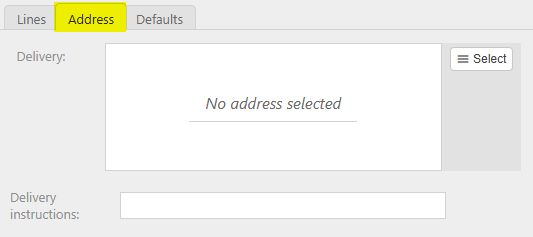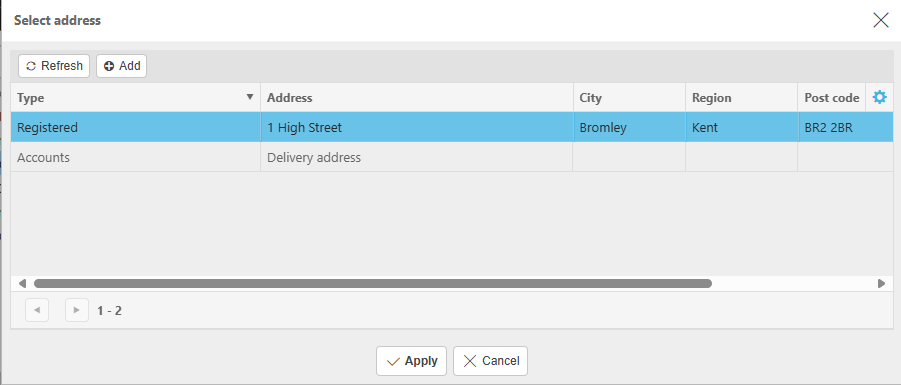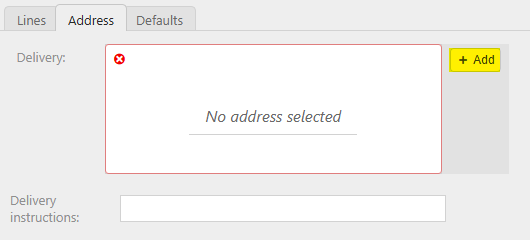Sale Invoices
The Sales invoice feature allows a variety of actions to be made to sales invoice. See below for more details.
A User must have the correct User roles permissions to use sales invoices.
Sales products and Customer must be setup to create invoices.
How to view Sales Invoices
Viewing a Sales Invoice
Select Sales / Invoices from the Main section of the pulse menu -
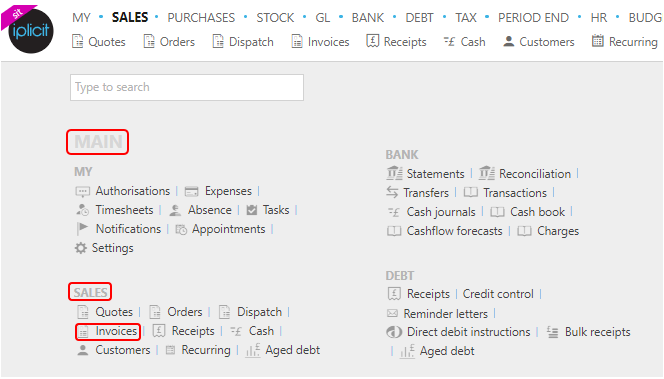
Note
This is an example screen shot of the pulse menu.
Position of the menu items within pulse will vary according to available options and dependant on personal screen resolution.
or from the Main Menu select Sales then Invoices -

or enter Sales Invoices in the Quick Launch Side Menu.

This will then show the Sales Invoices on the system where normal customisation of Sets can be used. Also, depending on User roles, the My/All option will be showing.

- DOC#: The code given to the document.
- Customer: The Customer that the invoice is for.
- Description: This describes the invoice.
- Invoice type: The Document type.
- Invoice date: The date the invoice was created.
- Due date: The date the invoice is due to be paid.
- Gross: The gross amount of the invoice.
- Outstanding: The outstanding balance left to be paid.
- Period: the period the invoice is listed in.
Tip
To modify the columns displayed, select  on the top right of the page, then tick/untick the information you want to hide or display.
on the top right of the page, then tick/untick the information you want to hide or display.
How to create a Sales Invoice
Create a Sales Invoice
Select Sales Invoices from one of the options as shown above in Viewing a Sales Invoice.
Select either New or New (from template) - from the dropdown menu.
Select the document required and select Create or select the pre-existing template and then select Apply.
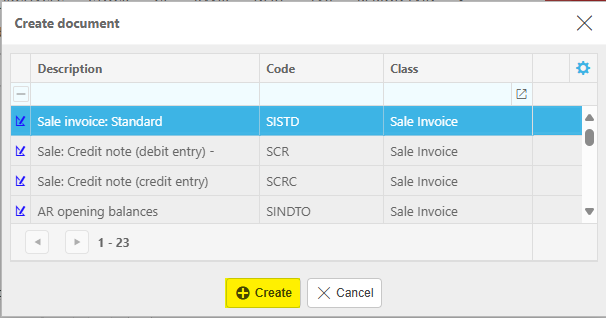
Enter data in the following as required -

Customer: select from dropdown options.
Invoice date: This will be auto filled; however, this can be changed.
Note
This date will default to the current date unless the Don't default current date option is ticked in Others tab within the Document type. In this case, when a user creates a new document this date is left blank.
Due date: Fill this out with the date that you would like the invoice to be due.
Period: This is the financial Period that the invoice will be logged in.
Description: Enter a description. If Description required option has been ticked in the Document type, then this field will be mandatory. It will be automatically entered if a Default description was entered in the Document type.
Invoice type: This will be auto filled with the Document type selected in step 3.
Legal entity: Pre-populated with the default Legal entity set within Document types, but this can be overwritten.
Department: Select from dropdown options.
Stock date: This date will default to the Invoice date. It can be changed, but will reset to the Invoice date if the latter is changed. If this date differs from the Invoice date, then a
 icon will show with a warning message saying Stock date / document date mismatch.
icon will show with a warning message saying Stock date / document date mismatch.
Note
Stock date date will only show if the Document type has Stock option selected and Enable stock selected in the resulting Stock tab.
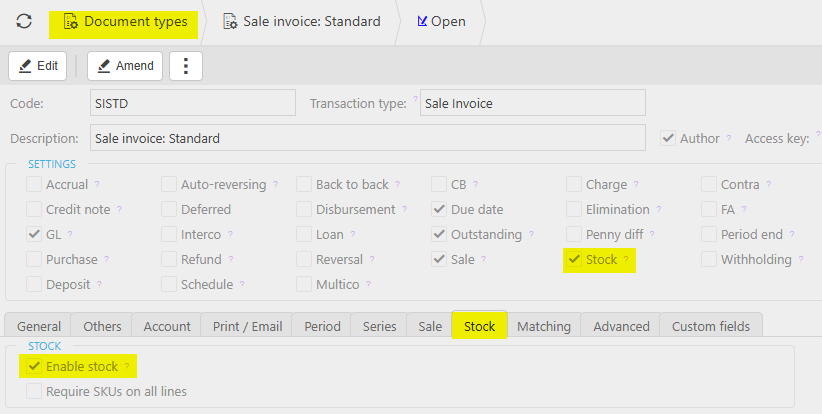
Their Ref: The unique reference given to identify the document. If Their ref required option has been ticked in the Document type, then this field will be mandatory.
Responsible: Selecting a User to be responsible will log the sales invoice under their name. This is useful for Authorisation Workflows.
Note
If a
 icon shows on the Customer field, this indicates the data entry control connection.
icon shows on the Customer field, this indicates the data entry control connection.
A similar
 icon appears in the posting attributes section.
icon appears in the posting attributes section.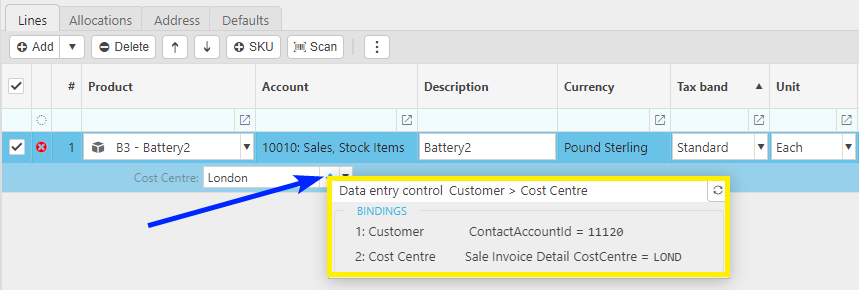

Lines
Stock date: If this date differs from the Stock date in the header section, then a
 icon will show with a warning message saying Line stock date / document stock date mismatch.
icon will show with a warning message saying Line stock date / document stock date mismatch.
Product: This is the product being invoiced.
Account: If a Product is being used, this will be auto-completed and read only otherwise select an Account from the available list.
Description: Depending on the Force change setting in Chart of Accounts

If the Force change is not ticked, then the Description field will be auto filled ...

... however, it can be edited.

If the Force change is ticked, then the Description field will be blank, and you will be forced to enter a description.

Project: You can link the invoice to a Project.
Unit: This is the Unit to measure the Product.
Qty: This is the quantity of the Product you are invoicing.
Unit price: This is the price per unit of the Product.
Posting attributes
The posting attributes are derived from the Chart of account rules related to the Account code. Common attributes include Cost centre and Department (select from dropdown list ordered as setup by "Order index" in Departments) but can also include custom attributes.
Note
Deferred Income
This item will appear depending on the settings for the Invoice type selected - see Deferred income guide for further information.
Also, this item may or may not be ticked, depending on the Customer's Ignore deferred income setting - see the Defaults section on the Customer tab in the Customers guide for further information.
If there is a requirement to sell to a Customer and have the goods delivered where the tax authority treatment is different, then set the Customer up as a Multi Tax Authority Customer.
Select either Submit once happy with details or Create as draft to be able to edit further before submitting.
Note
Returning to this document via the Edit option will notify other users viewing the same document that it is being edited.
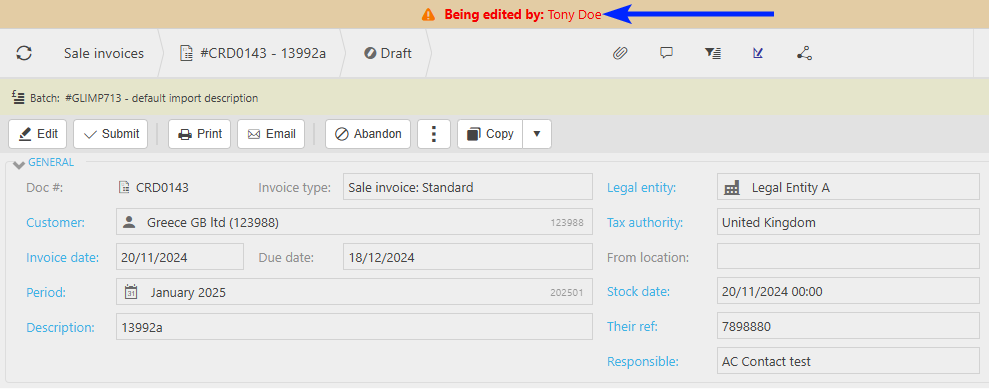
Tip
If you are going to be creating the same invoice on a regular basis, then create a template by selecting Copy, then press Copy to template.

How to create Sales Invoice disbursement
Sales Invoice disbursements
Select Sales Invoices from one of the options as shown above in Viewing a Sales Invoice.
Press New.
Select the disbursement Document type.

Choose the Project.
Fill in the remaining fields.
Invoice date: This will be auto filled with the current date; however, this can be changed.
Due date: Fill this out with the date that you would like the invoice to be due.
Description: This will be used to identify the sales invoice in the invoice finder.
Invoice type: This will be auto filled with the Document type selected in step 2.
Period: This is the financial Period that the invoice will be logged in.
Their ref: the reference for the invoice.
Press Disbursements.
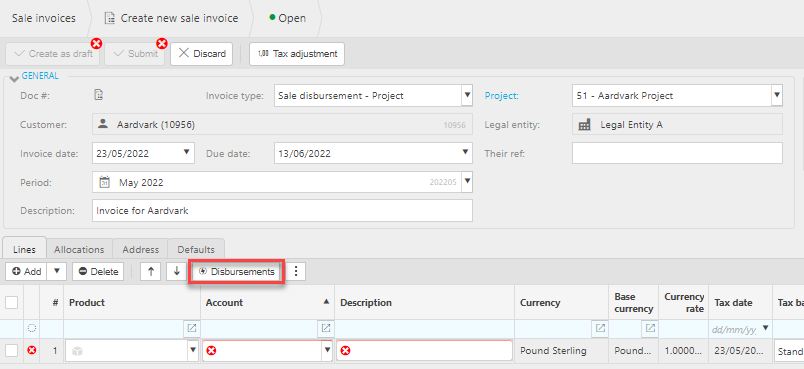
Now select from the Available disbursements then press apply.

When you are happy with the details, press Submit.
How to receipt a Sales Invoice
Receipt a Sales Invoice
Select Sales Invoices from one of the options as shown above in Viewing a Sales Invoice.
Select the invoice that you would like to receipt (receive the money for the invoice) then press Receipt.

Note
If Automated posting was enabled whilst creating a Payment Service, then the Receipt option will not be available.
Selecting the Allocations tab will show the automatically created receipt.
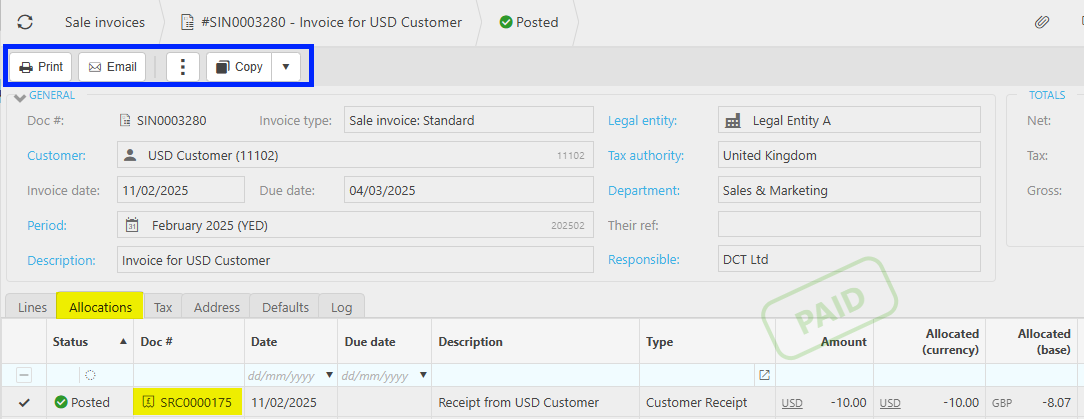
Selecting the Receipt - hold Ctrl, then select the Receipt doc ...

... will take you to the Receipt.
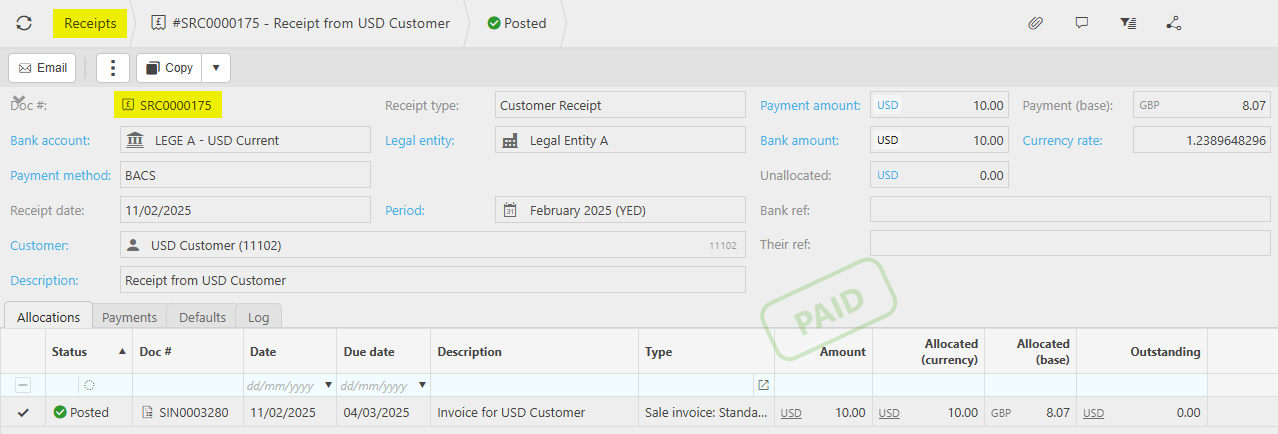
Note
Project: This shows the Project from the header of the Sales invoice if it has been entered.
If the Project field is not displayed, select the
 icon on the right of this tab section, then tick the Project field to display on the tab list.
icon on the right of this tab section, then tick the Project field to display on the tab list.If receipting the full outstanding amount, leave this amount in the Allocated (currency) field -

This amount can be any amount. If the amount is within pennies of the full outstanding amount, then the Penny Correction Automation (if the trigger setting is Automatic upon posting) will process the amount entered and a correction amount of a few pennies.

Further details - Penny Correction Automation.
Once amount has been entered, select Submit to process receipt.

Opening the Sales Invoice again, if the full outstanding amount was entered then it will now show as Paid.
If the amount was only pennies different, then the Sales Invoice will also show as Paid, and the Allocations tab will show with two transactions - one with the amount entered and one with the pennies receipt.

If only a part Receipt amount was entered, then the Sales Invoice will show the outstanding balance as the Gross less the amount on the receipt -

How to create payment via Payment Service
Paying a Sales Invoice via Payment Service
To pay a Sales Invoice via a Payment service, the Customer must be assigned with the Payment method, an active Payment service set up on the Legal entity and the Document type updated to allow Payment services.
Should you require to regenerate a GoCardless instant payment link, or an invoice was created without a link i.e. the customer account had not been updated prior to generating the invoice, this can be done via the  icon, and the GoCardless instant payment link will be added to the invoice.
icon, and the GoCardless instant payment link will be added to the invoice.
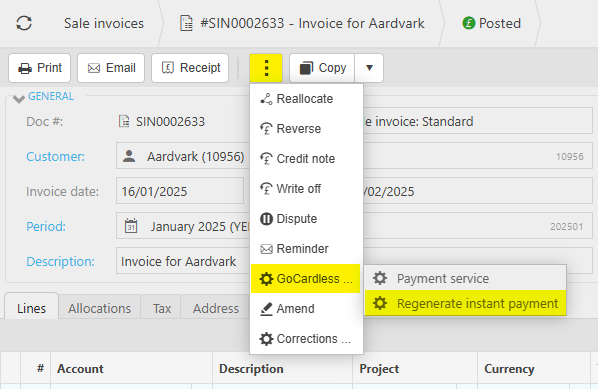
See Payment Services prerequisites for further details.
Select Sales Invoices from one of the options as shown above in Viewing a Sales Invoice.
Select and open the Sales Invoice.
If the prerequisites are set, the Sales Invoice created with these Customer and Legal entities, will automatically create a Payment request, which can be seen created in the Log tab.
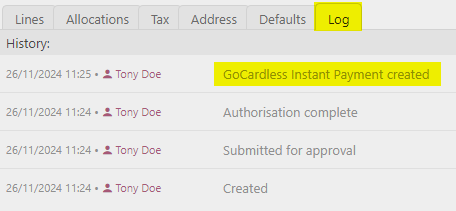
You can now send the Invoice to the Customer via email.
Select the Email button.

Select the Payment Services report from the dropdown list.
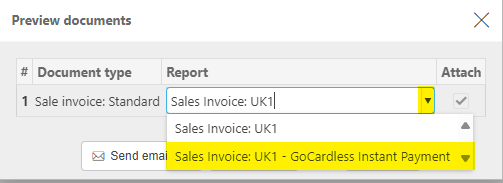
Select the
 button.
button.
Display the Sales Invoice by opening the Invoice.pdf.
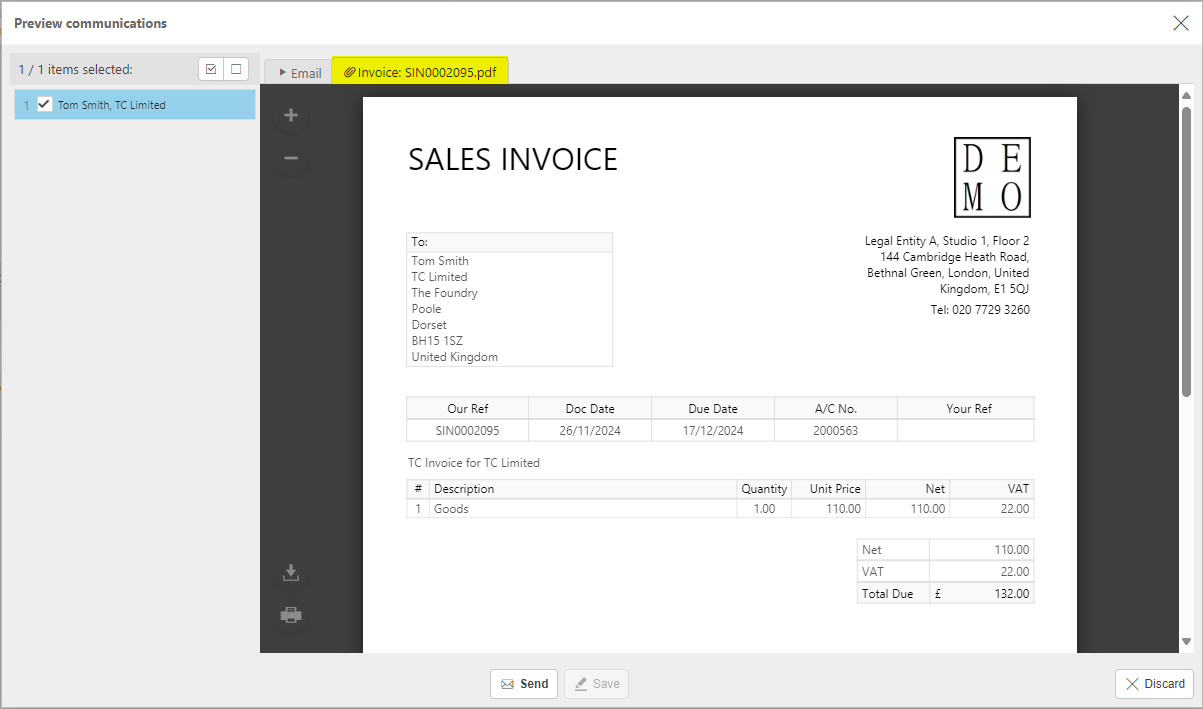
Scroll to the bottom of the Invoice and there will be a notification of the Payment Services.
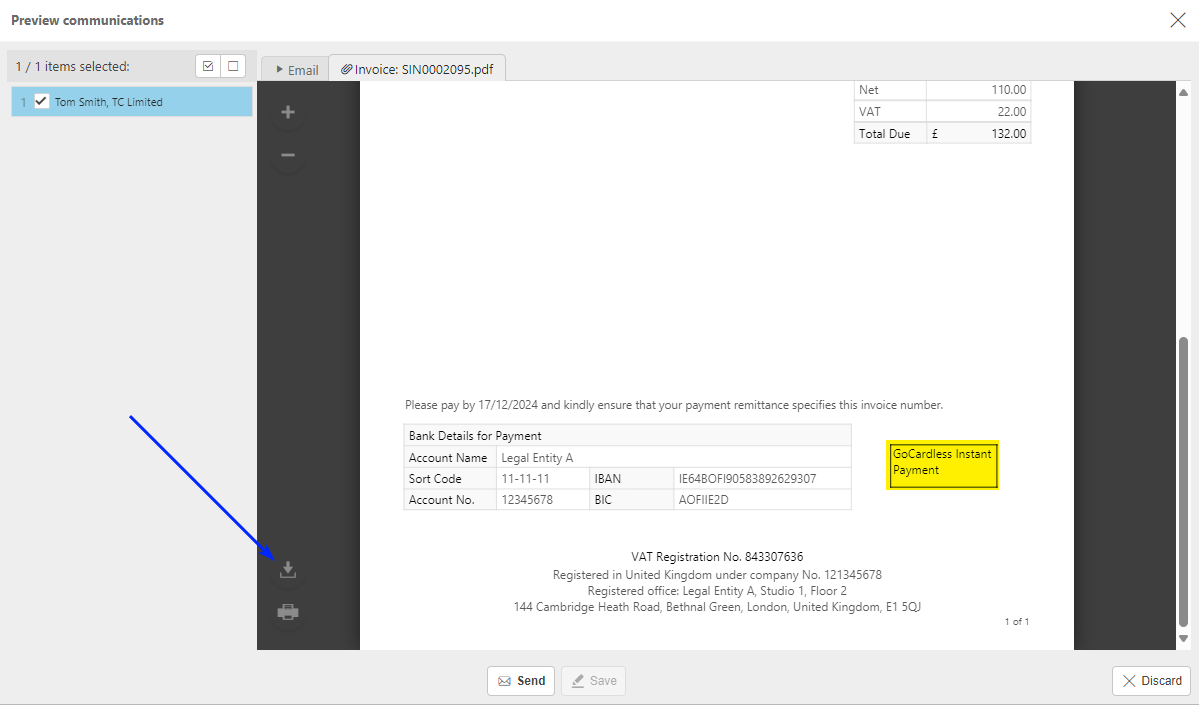
Select the
 icon to download the email preview.
icon to download the email preview.Select the payment notification box e.g. GoCardless Instant Payment
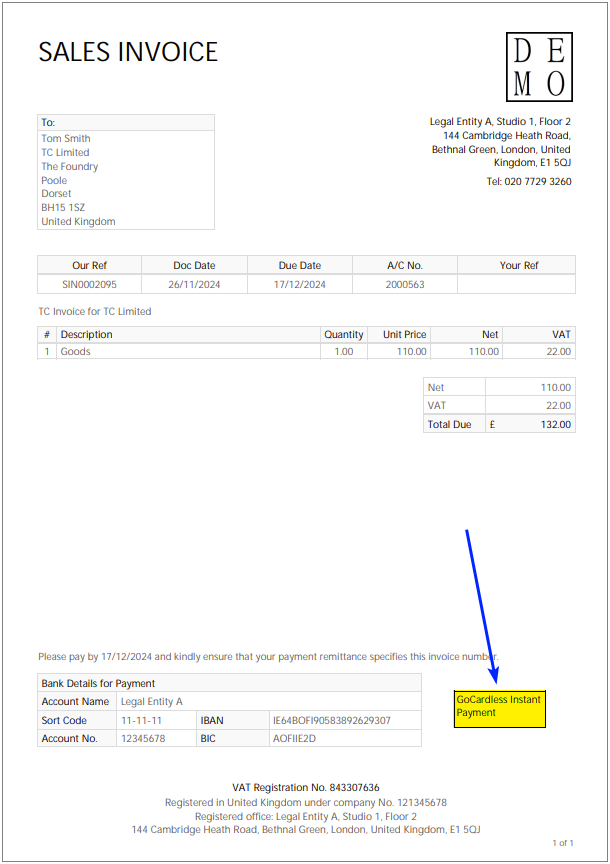
This will then take you to your Payment service provider for the Customer to enter personal details and agree payment.

Note
iplicit adds custom values to the metadata on GoCardless Payments and Mandates created via our integration.
To ensure correct functioning of the integration, this metadata must not be modified or removed in the GoCardless application.
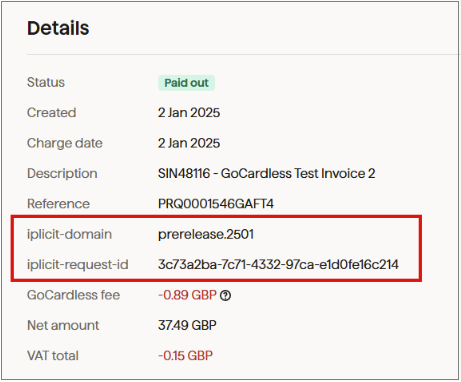
Once an Invoice has been paid via a Payment Service, then the Payment reference will show on the Sale Invoice finder.
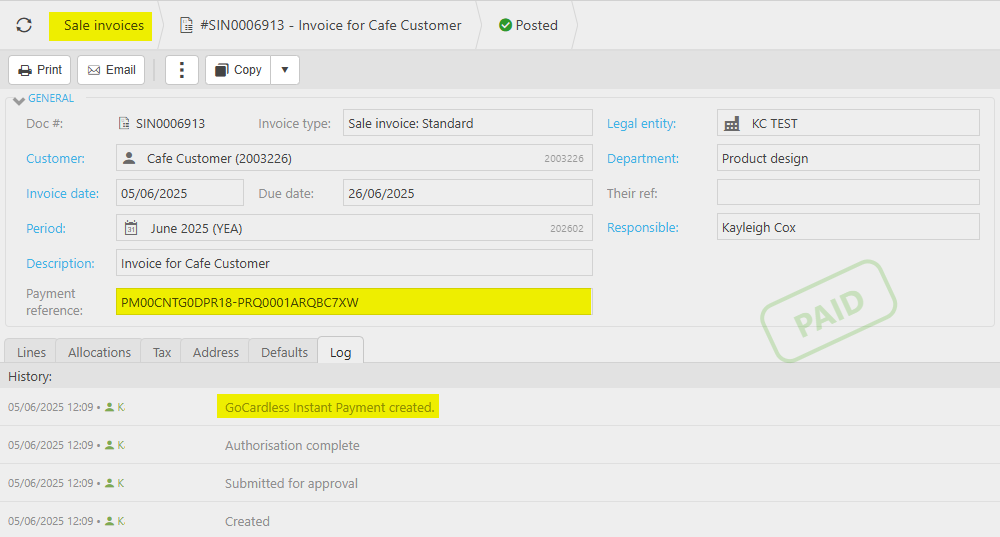
How to authorise a Sales Invoice
Authorise a Sales Invoice
When an Invoice has been created (if setup) the invoice will need to be authorised.
To do so, select the invoice then press Authorise.
Timesheet Sales Invoice
Timesheet Sales Invoice
Select Sales Invoices from one of the options as shown above in Viewing a Sales Invoice.
Select the invoice then press Timesheet invoice.

How to reallocate a Sales Invoice
Reallocate a Sales Invoice
Select Sales Invoices from one of the options as shown above in Viewing a Sales Invoice.
Select and open the posted Sales Invoice to reallocate.
Select the
 icon, then press Reallocate option.
icon, then press Reallocate option.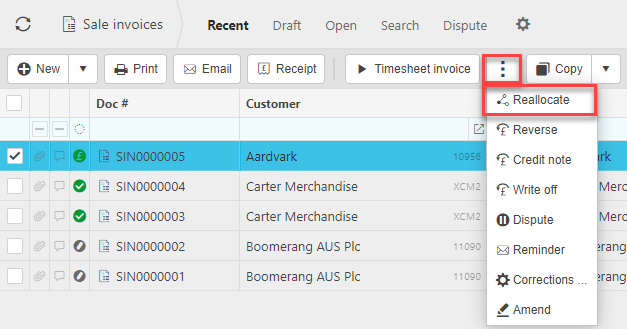
Enter changes, then select Apply.
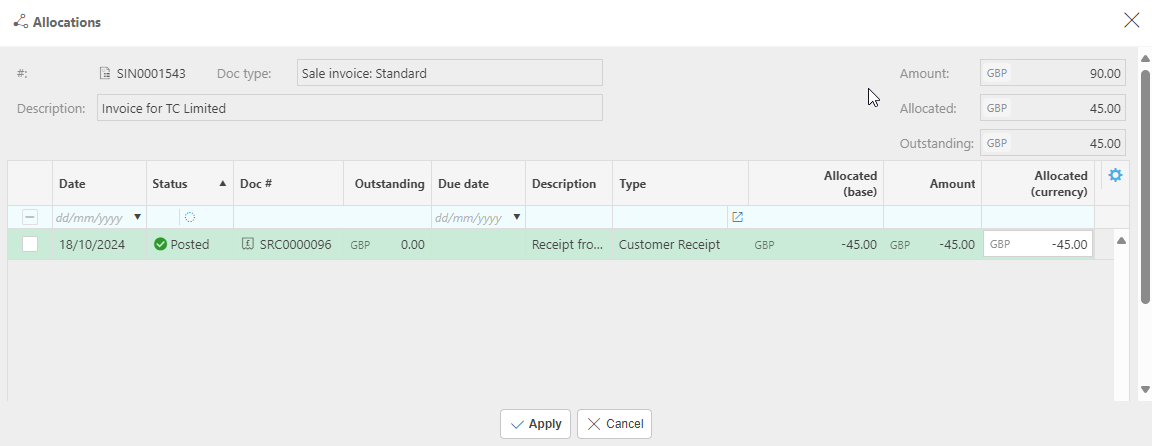
How to reverse a Sales Invoice
Reverse a Sales Invoice
Reversing an invoice will release the match from the Order
Select Sales Invoices from one of the options as shown above in Viewing a Sales Invoice.
Select and open the posted Sales Invoice to reverse.
Select the
 icon, then press Reverse option.
icon, then press Reverse option.
Note
If this is a Multi-co or Inter-co document and there are linked documents, then a warning that reversing will also reverse all linked documents.
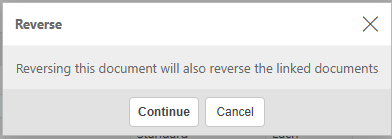
Enter the reason then press Submit.
How to create a Credit Note
Create Credit note a Sales Invoice
Select Sales Invoices from one of the options as shown above in Viewing a Sales Invoice.
Select and open the posted Sales Invoice to create Credit Note.
Select the
 icon, then press Credit note option.
icon, then press Credit note option.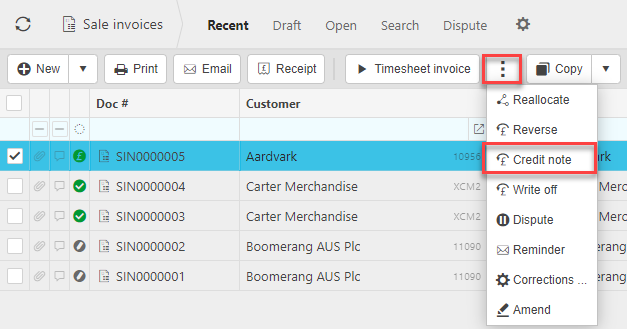
Select the credit type, then press Create.
How to Write-off a Sales Invoice
'Write off' a Sales Invoice
Select Sales Invoices from one of the options as shown above in Viewing a Sales Invoice.
Select and open the posted Sales Invoice to write off.
Select the
 icon, then press Write off option.
icon, then press Write off option.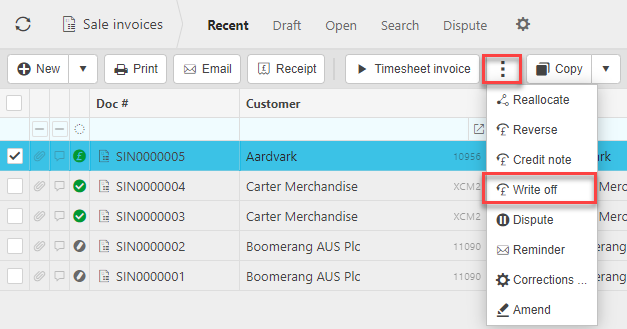
How to dispute a Sales Invoice
Dispute a Sales Invoice
Select Sales Invoices from one of the options as shown above in Viewing a Sales Invoice.
Select and open the posted Sales Invoice to dispute.
Select the
 icon, then press Dispute option.
icon, then press Dispute option.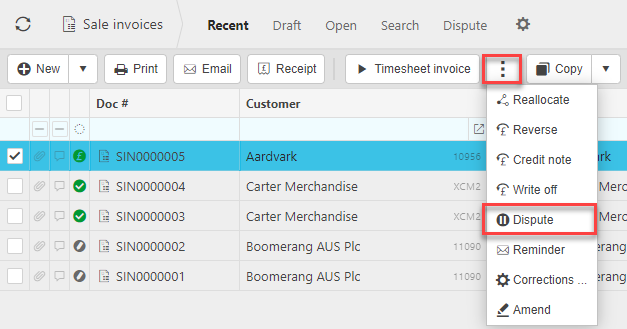
Select the dispute group and if required, a note.
Press Submit.
How to send a reminder letter
Send a reminder letter for a Sales Invoice
Reminders must be setup to use this feature.
Select Sales Invoices from one of the options as shown above in Viewing a Sales Invoice.
Select and open the posted Sales Invoice for the reminder letter.
Select the
 icon, then press Reminder option.
icon, then press Reminder option.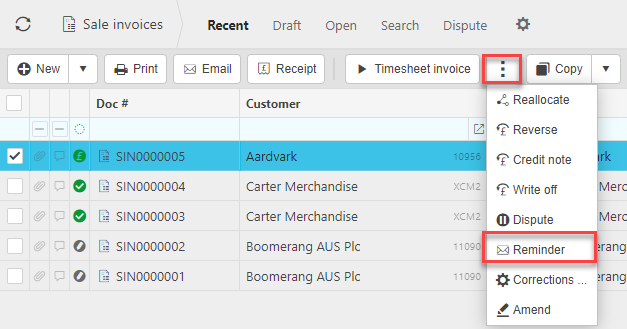
How to amend a Sales Invoice
Amend a Sales Invoice
Select Sales Invoices from one of the options as shown above in Viewing a Sales Invoice.
Select and open the posted Sales Invoice to amend.
Select the
 icon, then press Amend option.
icon, then press Amend option.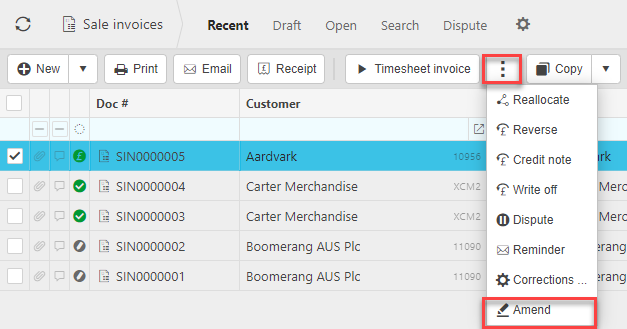
You can now make non-monetary changes to the Invoice details without having to Unpost first. These amendments will not have any effect on any of the Accounts.
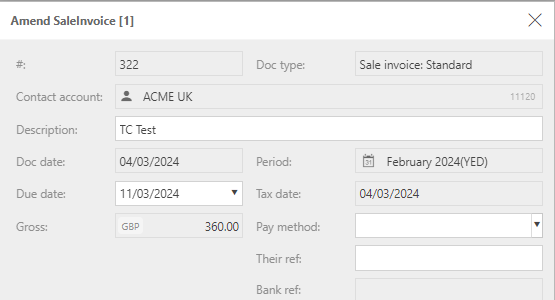
You can also make changes to Custom fields, which have previously been defined on the Custom fields tab when defining the Document type -
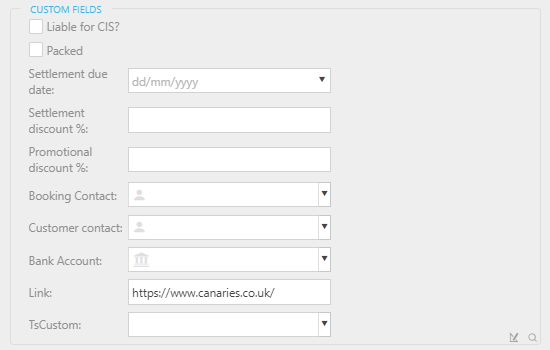
Note
User will need Attribute.Amend permissions.
Once complete, press Apply.
How to correct a Sales Invoice
Make corrections to a Sales Invoice
Select Sales Invoices from one of the options as shown above in Viewing a Sales Invoice.
Select and open the posted Sales Invoice to correct.
Select the
 icon, then press Corrections option.
icon, then press Corrections option.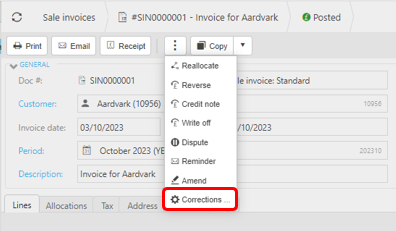
Period correction to make corrections to the Period.

Note
If the document has any linked documents, then a warning will show informing that changes will not be updated on any linked documents, and asking if you wish to continue.

Select Apply to complete correction.
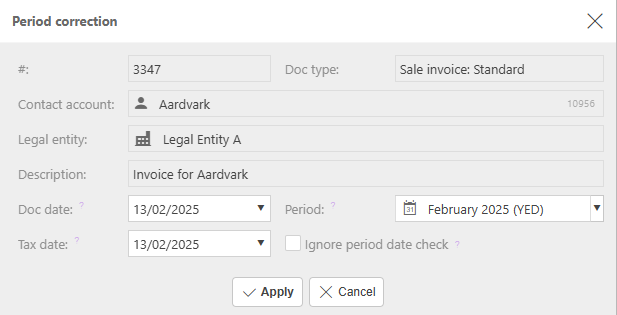
Unpost to retract the Purchase Invoice from the General Ledger

Note
If this is a Multi-co or Inter-co document and there are linked documents, then a warning that unposting will abandon all linked documents.
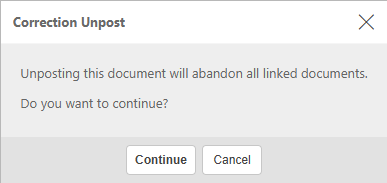
Select Unpost to complete correction.
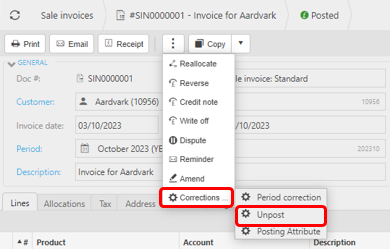
Posting Attribute to make corrections to individual attribute values on the Purchase Invoice.
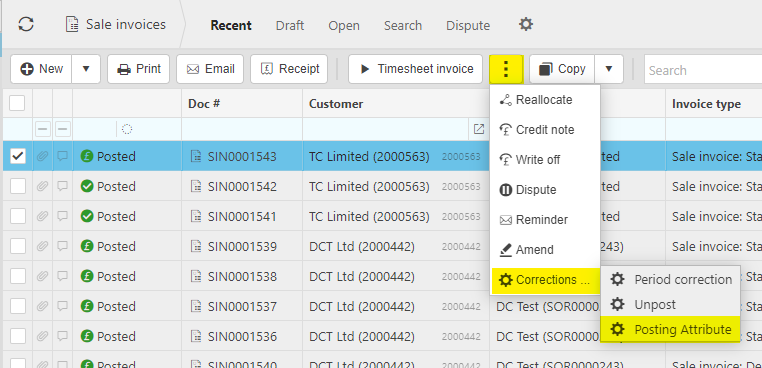
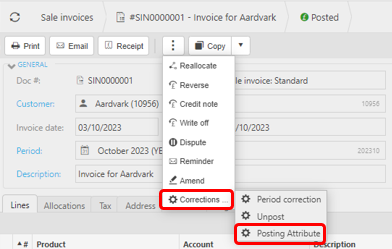
Warning
If the document has linked documents created via automation, then the corrections to the Posting Attributes will not be possible.
The option Posting Attribute will no longer show under Corrections.
See Correcting Posting Attributes for further details.
How to create a VAT only Sales Invoice
Create a VAT only Sales Invoice
Follow steps 1-5 in Create a new sales invoice.
When filling out the lines (step 6) select TAX only for the Tax band. You can now enter the tax amount whilst the product gross cost is 0.
When you are happy with the details, press Submit.
Updated June 2025
